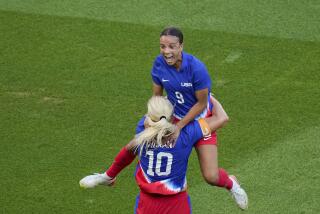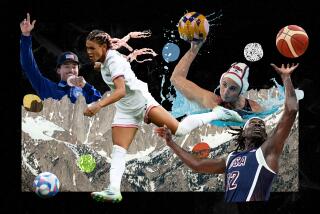U.S. Is Expected to Win as Many as 18, so It’s Probably Time to Let the Games Begin
- Share via
The Olympic Games offer an opportunity for the youth of the world to gather in a spirit of friendship, enjoying each other’s company as they learn the importance of values that transcend differences in nationality, culture and geography.
--Juan Antonio Samaranch, President, International Olympic Committee.
****
*
Yeah, right.
Tommy Moe and Picabo Street know it, Michelle Kwan and Tara Lipinski know it, Nike, McDonald’s and Coca-Cola know it, the American people know it--the Olympic Games, as they stand here and now, near the end of the ever-pragmatic, bottom-line 1990s, are about three things and three things only:
Gold, silver and bronze medals.
Give or take the silver and bronze, of course.
Medals are the currency of the Olympic movement as it lurches toward a new millennium, the subway tokens on the E train to fame, fortune, quickie book deals, cushy career turns in the NBC commentator’s booth and your name on the Rolodexes of talk-show booking agents for at least a good month and a half.
By now, each has its own assigned value and worth.
Gold gets you the cover of the Wheaties box, the side of the Campbell’s soup can, the trip to Disney World, your own official web site, 27 more “unofficial” web sites, the hardback “Golden Boy/Girl” as-told-to autobiography, the cameo voice-over on “The Simpsons,” the shoe-soda-and-cereal inner circle of celebrity endorsements, the guest spots on Leno, Letterman and “Saturday Night Live.”
Silver gets you a lip balm commercial, the cover of SI For Kids and “The Today Show.”
Bronze gets you a line of type in the next year-end sports almanac, your photo in your hometown newspaper and “Arliss.”
What do Albertina Noyes, John Lettengarver, Julie Holmes and Michael Woods have in common?
They were Americans who finished fourth during the Olympic Games in which Peggy Fleming, Dick Button, Janet Lynn and Eric Heiden won medals.
The greatest American moment in the history of the Winter Olympics?
The United States’ victory over the Soviet Union on the way to the hockey gold medal in 1980.
The most anticlimactic American moment at the Winter Olympics?
Neither Nancy Kerrigan nor Tonya Harding, protagonist and villain in the sporting soap opera of the decade, winning the figure skating gold medal in 1994 in Lillehammer--a bauble that went instead to a Ukrainian teenager, Oksana Baiul.
The lowest American moment at the Winter Olympics?
The medal total at the 1988 Calgary Games: a paltry six--only two gold--prompting a dire strategy known as the Steinbrenner Commission. New York Yankee owner George Steinbrenner, of all people, was enlisted to ride into town and clean up Dodge.
Headed by Steinbrenner, the 11-member commission examined the U.S. Winter Olympic problem and in 1989 issued its findings in a 21-page report that could have been edited down to four words:
We’re Americans, not Scandinavians.
The Steinbrenner Commission recommended that the U.S. Olympic Committee be streamlined--with the financial savings being funneled toward athlete development--while advising that more money be raised through marketing and corporate sponsorship.
“Winning medals must always be the primary goal,” the report concluded,
By 1994, American winter athletes were winning more Olympic medals--13--than ever before. And with such U.S.-friendly sports as snowboarding and women’s hockey on the program for Nagano, USOC officials are boldly forecasting an all-time haul at next month’s Winter Games.
Bill Hybl, USOC president, predicts 14 to 15 American medals. Paul George, USOC vice president, predicts 18, but duly notes, “I’m an optimist.”
Eighteen medals?
Reality-check time: In 1994, the United States won six gold medals--four by athletes since retired (Bonnie Blair, Dan Jansen and Diann Roffe-Steinrotter) and another by Tommy Moe, currently buried in 35th place in the men’s World Cup downhill standings.
Kerrigan, the women’s figure skating silver medalist in 1994 is gone, and Picabo Street, the women’s downhill silver medalist in Lillehammer, is in only her second month of competition after knee surgery.
On the plus side, post-1994, American gains have been made in:
* Figure skating, where the United States has three probable medalists--Kwan, Lipinski and Todd Eldredge.
* Men’s hockey, with the inclusion of such NHL stars as Brett Hull, Mike Modano, John LeClair and Chris Chelios.
* Freestyle skiing, where half a dozen competitors have fair-to-good medal chances.
* And, white-knuckled fingers crossed, luge and bobsled, where the U.S. has encountered encouraging--if not delusional--recent World Cup results.
The introduction of women’s hockey and snowboarding as full-fledged Olympic sports could mean as many as four more medals for the Americans . . . but 18, all told?
Turning over frozen stones above the Japanese timber line, we search for those 18 American medals.
In order of descending probability:
1. Michelle Kwan. The gold-medal favorite in women’s figure skating is coming off a historic performance at the U.S. championships--seven perfect artistic scores of 6.0 in her short program, eight more in her long program. Kwan was world champion in 1996, a title she lost to Lipinski in 1997 during a sudden--and since cured--two-month siege of the flutters.
2. Tara Lipinski. Europe might have one skater capable of elbowing in next to Kwan and Lipinski on the medals podium, but not two.
3. Women’s hockey. A sure-fire way to boost that U.S. Winter Olympic medal total: Keep adding sports Americans are good at. Women’s hockey is one--Canada and the United States will play for the gold medal; the rest of the world is waiting for 2002. Snowboarding, which we invented, is another. And what shall we add next? Frozen turkey bowling? Winter league baseball? Stock car racing with chains on ice?
4. Men’s hockey. Oh, right, here’s one: Olympic hockey with NHL professionals permitted admission. Under a similar format, the United States’ NHL all-stars defeated Canada’s NHL all-stars for hockey’s World Cup in 1996. Canada, the United States and Sweden--not necessarily in that order--all figure to win medals in the Olympics’ first “Dream Team” hockey tournament.
5. Todd Eldredge. The 1996 men’s world figure skating champion doesn’t have the jumps to match Canada’s Elvis Stojko, but he skates the most consistently clean programs in the Nagano field. If Stojko and Russians Ilia Kulik and Alexei Yagudin take their flying leaps and fall on their quads, Eldredge could slip in for the gold by simply staying on his feet.
6. Chris Witty. Even with the “Next Bonnie Blair” weight creasing her shoulders, Witty set the world women’s 1,000-meter speedskating record in 1997 and won the gold medal in the same event at last week’s 1998 world championships. She will be favored at 1,000 meters in Nagano and could also win a medal at 1,500 meters.
7-8. Men’s freestyle skiing. Two possible U.S. gold medals here--Jonny Moseley in moguls and Eric Bergoust in aerials. Moseley leads the current World Cup standings and Bergoust won silver at the 1997 world championships barely a month after breaking his collarbone. He routed a World Cup field last weekend at Whistler, Canada, and leads the standings.
9-10. Women’s freestyle skiing. The U.S. Ski federation is touting three women’s mogul skiers, Liz McIntyre, Donna Weinbrecht, Ann Battelle, and an aerialist, Nikki Stone, for medals next month. Credentials: Weinbrecht won the gold medal in Albertville, McIntyre won the silver in Lillehammer, Battelle is second in the current World Cup standings. Stone won the 1995 world championship, won Sunday at Whistler and leads the women’s World Cup aerial standings. Four medals here might be pushing it; two sound within reason.
11-12. Snowboarders Mike Jacoby and Sondra Van Ert. Two American medals from the first Olympic snowboard competition may be a conservative estimate, but trying to forecast the break-neck halfpipe event is a crapshoot. Giant slalom tends to hold form more often, and the United States has two of the world’s best practitioners--Jacoby, two-time men’s World Cup points leader, and Van Ert, women’s world champion in 1997.
13. Picabo Street. That fourth-place finish by Street at Cortina last week was a stunner--the best news for U.S. skiing since Street won her 1996 women’s downhill world championship. Torn knee ligaments kept Street off the slopes for most of 1996-97, but her steady progress in World Cup events in December and January signals hope for at least one U.S. medal in Alpine skiing.
14. Two-man luge. Still searching for that first Olympic luge medal, the United States has two of the four top-ranked two-man teams on the World Cup circuit. Sunday, Mark Grimmette and Brian Martin clinched the 1998 World Cup title with a victory at Winterburg, Germany. The team they supplanted for the championship? Americans Chris Thorpe and Gordy Sheer, who finished fourth in the 1998 World Cup standings.
15. Kristina Koznick. The slalom specialist from Burnsville, Minn., has timed her pre-Olympic surge perfectly--three fourth-place World Cup finishes and a second in an event no longer dominated by Switzerland’s Vreni Schneider, who retired, or Sweden’s Pernilla Wiberg, who’s hurt. This time next month, Koznick’s hometown could be known as Bronzeville.
16. Nicole Bobek. Those unruly chants of “Sweep! Sweep! Sweep!” in Philadelphia earlier this month? Just the U.S. women’s figure skating team assessing its medal chances in Nagano. It won’t be easy, especially if the European judges vote in blocs, but Bobek, U.S. champion and world bronze medalist in 1995, has the goods.
17. Wendel Suckow. America’s best singles luger has a reputation for peaking in big events--he won the world championship in 1993 and a World Cup race in Nagano in 1997. His biggest event yet awaits on that same track.
18. Pairs figure skating. Wishful thinking here, but it’s either this or bobsled, where the Americans are notorious for walking the walk but seldom sliding the slide. Europeans swept the pairs medals at the 1997 World Championships, but the U.S. tandems of Kyoko Ina-Jason Dungjen and Jenni Meno-Todd Sand placed fourth and fifth, respectively. If a Russian or a German happens to go boom, one of these teams could move up to third.
Do you like longshots? Try Todd Lodwick, who scored the first World Cup victory by an American in Nordic combined in a dozen years last season. Some say he could challenge for bronze in the event that combines ski jumping and cross-country skiing.
More to Read
Go beyond the scoreboard
Get the latest on L.A.'s teams in the daily Sports Report newsletter.
You may occasionally receive promotional content from the Los Angeles Times.








